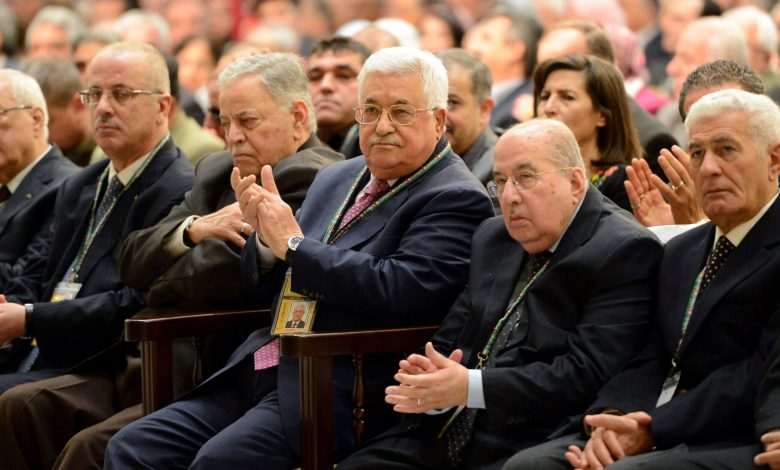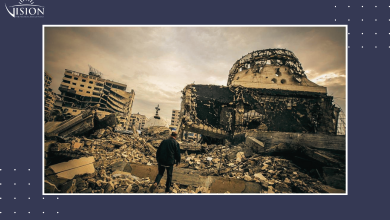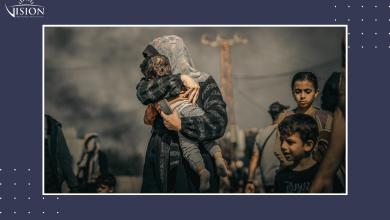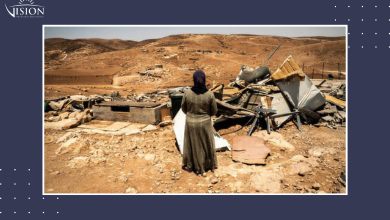Dismissal of Fatah Leaders: Implications and Repercussions

Vision Center for Political Development
Introduction
On May 1, 2022, Fatah Movement issued a resolution, signed by the faction’s and Palestinian President Mahmoud Abbas, providing for the dismissal of 40 of its members and leaders after their candidacy for the second phase of municipal elections, held on May 26, 2022, within separate lists of Fatah’s official electoral rolls. This succeeded the movement’s crushing defeat after the Islamic bloc, Hamas student bloc, had won a landslide victory in the Student Council elections, on May 18, of Birzeit University in the north of the occupied West Bank city of Ramallah. Correspondently, this has triggered critiques against the movement’s policies and its solo leadership.
In response, Fatah’s Secretary in Ramallah and Al-Bireh, Muwaffaq Sahweil, stepped down in a move that preceded similar resignations by other Fatah members amid the suspension of Fatah’s regional offices on the grounds of a decision to freeze its work due to its solo decision making, leading to its remarkable great loss. This came in the wake of the dismissal of a group of Fatah leaders and national figures, most prominently, Nasser al-Qudwa, former member of the central committee in the Fatah movement, for their candidacy for the Palestinian Legislative Council elections, were supposed to be held in May, 2021, within separate lists from Fatah official listings.
This transformation within Fatah was not the first of its kind for it has historically been witnessing a lot of dismissals, resignations and internal divisions. However, what has recently been taking place makes it necessary to understand the nature and the consequences of such rough changes. This paper, issued by Vision Center, aims at analyzing data and presenting an assessment of Fatah’s successive developments in the form of answers to the following questions addressed to academicians and experts in this regard:
- What are the implications of the latest dismissals and resignations within Fatah?
- Do these transformations pave the way for greater future developments in the structure of the organization that would lead to the domination of certain figures?
- How could these changes affect the trust of Fatah’s members and grassroots in the movement?
- To what extent would Fatah’s transformations affect the Palestinian internal relations, especially with regards to unity and putting an end to division, or even the management of the Palestinian Authority (PA) and government, as being melted within the two bodies?
Implications of Dismissal Decisions
With regards to the recent dismissals and resignations of Fatah members, the experts opine that the reasons behind these controversial resolutions included the following:
- The internal system of Fatah movement provides for the necessity of investigation before enforcing any punishment; thus, violating this provision makes the dismissal decisions void.
- By central decisions, the movement tries to restrict the lack of discipline phenomenon of its leaders and members, which are obviously demonstrated during elections, either the legislative (last year) or the municipal elections (this year).
- The emergence of new Fatah leaders has been associated with the enhancement of its exclusion policy.
- Some experts interpreted the decisions as a threatening message from Fatah leadership implying the provision that making any solo behavior without the consent of the movement holds members accountable and subjects them to punishment.
- These resolutions point to an internal crisis with Fatah as a renewable conflict the movement struggles with every now and then. The conflict involves Fatah’s internal divisions and weaknesses added to the state of chaos that is reflected in the movement’s performance.
- Such conditions reflect the impossibility of decision making by consensus, resulting in the fact that some Fatah members have got to know the decisions from the media rather than by direct organizational notification.
- These decisions also indicate Fatah movement’s attempt to frustrate the emergence of potential competitive figures in light of its successive crises.
As for the temporal manifestations of this phenomenon, the responses of the participants comprised some key notes summed up below:
- Taking into consideration that these decisions were made before Fatah’s eighth conference, the movement may be taken as aiming at neutralizing some figures who constitute an obstacle on the way of approaching leadership’s sensitive positions by some of Fatah’s powerful leaders.
- The decisions might also be interpreted as key steps within Fatah’s arrangements for the future phase where there is a strong probability of power take over in case President Mahmoud Abbas passes away. Therefore, this could be perceived as a procedure that paves the way for the coming of new leadership and neutralizing opponents who may hinder a smoothly set up of power transmission.
- Fatah also seeks to regain its hegemony and power which have been lost as a result of its accumulated defeats and failures, especially running for municipal and legislative elections in separate nonofficial lists by some of its figures and members.
However, these resolutions meant nothing to others who argue that Fatah’s decisions were produced within a normal context, claiming that its significance stem from constituting a reformation attempt more than resulting from its timing. This is because it goes in line with the movement’s organizational vision by Fata’s leaders who are keen on the guaranty of procedural legitimacy in consistence with internal consensus stipulated in the Movement’s internal system.
Repercussions on Institutional Structure
It has been agreed upon by the experts that Fatah’s latest dismissals of many of its leaders and cadres will definitely lead to obviously negative influence on Fatah’s internal unity, especially at the time where the movement has been going through several internal crises. They attribute such negative reflections to the following points:
- It cannot be claimed that Fatah’s institutional structure is collapsing. Yet, there are some fractions resulted from the act of taking control over significant intersections inside the movement by some key figures, who have become more powerful and more capable for decision making.
- Recent Fatah dismissals broaden the movement’s internal gap and conflict, leading to additional divisions and disputes.
- Over recent years, Fatah has been suffering from weakness of its organizational and institutional structure as most of its resolutions are issued individually without considering organizational references.
- The dismissals will negatively affect Fatah’s grassroots.
- The dismissed figures constitute a new foundation that would form new opponent bodies who seek any given opportunities to penalize Fatah.
- The potential collapse of Fatah’s institutional structure resorts to the absolute integration and identical representation of Fatah movement and the PA where the organizational body of the movement has been totally integrated within the official body of the PA.
- The decisions contradict the movement’s internal regulations and have already led to defamation while bearing in mind that some figures ran for elections in separate lists of Fatah’s official electoral lists and yet were not dismissed, which proves that decisions were made individually and independently of organizational reference.
- The movement has been recently facing a crisis of the domination of powerful leaders or what so called the crisis of inheriting the President amid concerns of the incapability of any potential leader to fill the gap after the President passes away. Accordingly, the institutionalization of the movement becomes at risk whenever it is dominated by individuals rather than an organizational law.
- The dismissal decisions reveal some influential and effective Fatah power hubs that gain their strength from Mahmoud Abbas’s presidential support, making them capable for imposing their vision, which annoys rival Fatah leaders.
Impact of Decisions on Fatah’s Grassroots
Variant interpretations of the repercussions of Fatah’s dismissals on its grassroots would be concluded in the following points:
- Despite the chaos, Fatah yet enjoys a massive popular base designated with fluidity and national mobilization, which makes it popularly supported.
- The recent issues may reflect a decline in Fatah’s power and popularity in terms of trust and performance satisfaction, which would be prominently demonstrated at any coming phase of elections.
- One of the direct effects on Fatah’s grassroots is the fact that they have become holding the movement responsible for all the flaws of the PA as well as the government.
- Yet, the decisions will not affect the unity of the movement because the dismissed figures had already decided not to run for the elections under the name of Fatah movement.
- Winning elections within nonofficial electoral lists of Fatah has led to placing more trust in Fatah leaders as independent figures more than the trust in the movement. Interestingly, this means more prospect divisions within the organization.
- A massive outrage and trust decline have come to the fore due to Fatah’s exclusion policy and its solo internal administration, accompanied by the continuity of declination in Fatah’s organizational reputation among the movement’s cadres and proponents.
- A state of timidly outrage has been prevailing among the youth of Fatah’s proponents because of the performance of the movement’s leadership. This can be also attributed to the gap between Fatah’s political leadership and the youth segment within the organization in terms of patriot and psychological motives, which questions the trust of non-organized Palestinians who would prefer to keep detached from the movement under such circumstances.
- The popularity of Fatah has been remarkably declined to a large extent in which its status has shifted from being capable for embracing almost all the Palestinian people to a situation of being internally untrusted among its own members and proponents, which labels the movement as incapable for mobilizing the Palestinians.
Evaluation of internal trends:
Regarding new prospect internal repercussions, it is believed that Fatah’s transformation would take the following shapes:
- Corrections to maintain the unity of the organization and the containment of any new bodies that would be formed later on.
- A new-developing Fatah transformation from an ideological movement to an emotional body; this is because the supporters of both Mohammed Dahlan and Marwan al-Barghouti have opposite standings due to being merely angry at the movement’s decisions without any solid procedural positions except for being contradicting with Fatah’s status quo.
- Some of the dismissals of national figures will deepen the division among the movement’s members who would demonstrate a tendency to join other resistance factions regardless of ideology, which explains the emergence of new resistance parties that do not possess a clear-organizational framework.
- Some Fatah figures are probably going to invest these transformations into mobilizing new grassroots, especially among the backers of al-Barghouti who is taken as an organizational role model.
- The tendency of Fatah’s members towards the containment of other new trends within the movement, most recognizably the proponents of al-Barghouti.
- Due to anticipated sympathy with the dismissed figures for being revered and venerable national personalities, the decisions will negatively affect the organization.
- The search for new trends within Fatah that would be activated in the body of the movement rather than attempting to replace it with an alternate organization.
- The ongoing isolation of Fatah’s powerful leaders from Fatah’s cadre, which is strong, dynamic and popular, will end up in the tendency to strengthen the cadre’s power; either by the support of popularly respected leaders such as al-Barghouti or even by financial support granted by other leaders such as Dahlan.
- A probable formation, by the dismissed figures, of a new organization which would literally act as an alternative body to Fatah.
- A prospect exploitation by Dahlan, who possesses a great power in the Gaza Strip with a wide grassroots of backers, of any disputes within Fatah in Gaza or even in the West Bank in case of any coming elections.
Internal consequences
The answers point to the fact that internal discrepancy within Fatah and the ongoing dismissals and resignations would definitely affect the Palestinian political system, internal reconciliation and the relations between Fatah and other factions for the following reasons:
- Internally, the presidential and legislative elections have not been taken place for over 15 years amid lack of democracy, electoral and representational rights and the absence of social justice. However, on the national dimension, the failure of the PA, which definitely means the failure of Fatah, to meet the Palestinian ambition of putting an end to Israeli ongoing violations and criminal practices against the Palestinians.
- The neutralization of the PLO from political practice along with nonrenewal of its structures due to frozen elections and the lack of substitutions that resulted from total integration of Fatah and the PLO within the PA bodies.
- Fatah’s exclusion policy would entail more natural future exclusions of more cadres, which means maintaining the status quo of the organization at the long run. This accordingly would lead to the continuation of the PLO’s distance from political practice and then the adherence to its traditional impotent structures.
- Fatah’s political system cannot let go some key figures who have become so powerful to the extent that they take control of the management of the organization leading to the fact that the movement’s decisions are made individually rather than by Fatah’s central committee.
- Such decisions reflect Fatah’s solo administration of the movement which is in urgent need for active institutional structures such as the Legislative Council.
- No interests can be foreseen in the intersection between Fatah and the PA whereas powerful leaders of Fatah are themselves the same powerful leaders of the PA as well as of the PLO.
- Fatah’s transformation will affect its administration of the Palestinian political system, which weakens the organization’s performance at the PA institutions.
Conclusion
As one of the earliest widespread Palestinian factions powerfully influencing massive audiences of Palestinians, Fatah would be affected, by any prospected crises not only at its internal level but also at the level of the Palestinian national status. Given that, Fatah’s resolutions must be made wisely in order to be able to regain power and reputation of its history and national struggle. This can be achieved by reactivating the institutions and departments of the movement and making sure that decisions are made with organizational consensus as well as appreciating its activists. Otherwise, the effectiveness of Fatah as a national liberation movement would be uncommonly affected due to accumulated declines especially following the passive relation between Fatah and the PA. However, the relation between the two Palestinian bodies should be carefully explored in order to guarantee organizational rights of all Fatah members to take part in decision making.
Vision Center’s thanks and gratitude are addressed to each of the academicians and researchers who participated in this political analysis and assessment report, and special thanks go to:
- Osama Abdullah, Mass Communication Professor at An-Najah National University.
- Amjad Bushkar, PhD Researcher in Political Science.
- Tayseer Fattouh, Secretary of Palestinian Justice Party.
- Thamer Sabaneh, Activist and Researcher in Political Development.
- Raed al-Deby, Political Science Professor at An-Najah National University.





